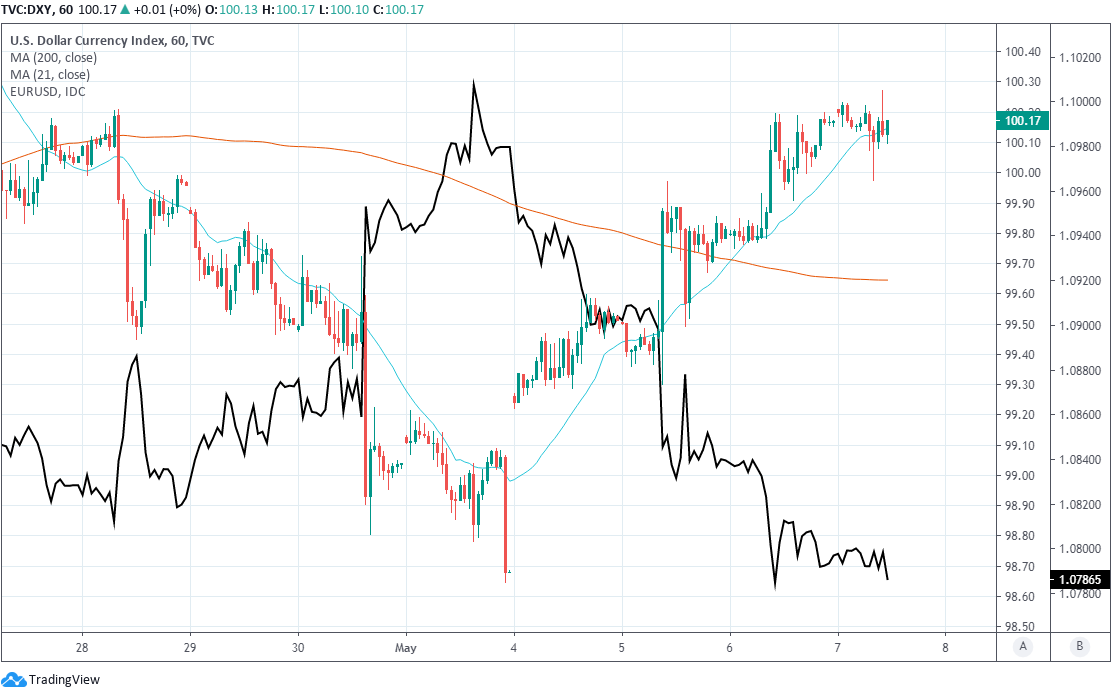Dollar Takes Risk Rally On Chin as Lacklustre Euro-to-Dollar Rate Throws Greenback a Lifeline
- Written by: James Skinner
-
- Lacklustre EUR, CHF and JPY aid USD Index higher Thursday.
- Softness also seen in DKK, NOK and SEK but GBP advances.
- U.S.-China deal talks loom amid fresh tensions over coronavirus.
- As European politics haunt EUR, threaten continental recovery.

Image © Adobe Images
- GBP/USD spot at time of writing: 1.2366
- Bank transfer rates (indicative): 1.2034-2121
- FX specialist rates (indicative): 1.2181-1.2256 >> More information
The Dollar Index edged higher on Thursday due to a lacklustre performance from some European currencies, which came as risk assets responded to stronger-than-expected March trade figures and reports suggesting the U.S. and China will look to implement their trade deal from next week.
U.S. exchange rates were a mixed bag on Thursday but crucially for the Dollar Index, the Euro and Swiss Franc were in all-out retreat, which helped lift the ICE barometer that measures the American currency relative to the Franc, Euro, Yen, Pound, Canadian Dollar and Swedish Krona. The Krona, which accounts for just less than 5% of the index, was also soft but it was weakness in the Euro and Franc that collectively account for 60% of the index that did the heavy lifting ahead of the Victory in Europe public holiday for the UK and France.
"Our near-term trading view is downside in EUR/USD for the next 1m (1.06) with a potential recovery into year-end (1.12), as we may be past the peak of COVID-19’s impact. However, risks are skewed further to the downside than the upside in EUR/USD because of the euro area economies’ high dependence on trade, tourism and travel, which will struggle to recover in the post-COVID-19 landscape," says Jordan Rochester, a strategist at Nomura.
Above: Dollar Index shown at hourly intervals alongside Euro-to-Dollar (black line).
The Euro-to-Dollar rate was -0.10% lower at 1.0787 mid-way through the European session Thursday but accounts for 57% of flows measured by the Dollar Index, explaining a substantial part of the greenback's 0.12% intraday gain. The Euro was lower despite a strong increase in the Chinese Renminbi that it's normally quite closely correlated with, indicating domestic European concerns could be behind the weakness seen in the single currency. China rallied after a strong increase in exports more than offset for the March trade balance, weakness in imports derived from a collapsed domestic economy.
The Australian Dollar was also on the offensive for similar reasons, although they and the wider market were also encouraged by reports suggesting talks will take place next week with a view to organising the implementation of January's agreement that ended the trade war between the U.S. and China. Tensions are however, rising again amid U.S. allegations the coronavirus originated from a research lab in Wuhan. Pound Sterling was up 0.31% at 1.2366 against the greenback after the Bank of England granted it a stay of execution.
Above: AUD/USD rate shown at daily intervals alongside Euro-to-Dollar (black line).
"The euro has been under pressure for the past three sessions, with the move lower accelerating in the wake of the German constitutional court decision. The move has taken EUR/USD decisively below the $1.0890 near to medium term pivot and towards the lows of the recent range $1.0725/$1.1015 again. The question is whether the market will now be breaking this support between $1.0725/$1.0770," says Richard Perry, a senior analyst at Hantec Markets.
European investors may have been perturbed Thursday by industrial production figures emerging from France and Germany as well as retail sales numbers from Italy, although neither release told the market anything it didn't already know. March industrial production fell much more than consensus expected in both countries while Italian retail sales contracted by more than a fifth during a month that was marred by three weeks of national 'lockdown'.
Above: USD/CHF rate shown at daily intervals alongside Euro-to-Dollar (black line).
"The euro remains under modest selling pressure following the German Constitutional Court’s decision," says Lee Hardman, a currency analyst at MUFG. "There is now more uncertainty over the future firepower of the ECB. While it seems unlikely that asset purchases will be curtailed during the COVID-19 crisis, there could be more pressure to withdraw support more quickly once the crises ends. It plays into fears already building over debt suitability in peripheral euro-zone countries such as Italy and Spain which could trigger instability in their debt markets and potentially the re-emergence of re-denomination risk further down the line."
The Euro's underperformance was incongruous with the broader market mood and its frequent role as a proxy for risk appetite, indicating continued unease in the market over Tuesday's ruling by The Federal Constitutional Court in Karlsruhe that the ECB "neither assessed nor substantiated that the measures provided for in these decisions satisfy the principle of proportionality," when launching its first quantitative easing programme in 2015.
Above: Euro-to-Dollar rate shown at daily intervals.
"The “core German message” it sends is one of ongoing suspicion of the persistent stretch towards monetary and fiscal policy merging into the same process, especially across national borders in the euro area. This is precisely the opposite of the clear position of the dominant political class in key countries like France and Italy who seem only too happy to water down all possible barriers between these various economic policy tools both within and across borders. Meanwhile we are left with an environment where further legal challenges are a near certainty, especially given that the new PEPP policy is clearly breaching the constraints the ECJ had pointed to (capital key and issuer limits) when it had OK’d in 2018 the legality of the PSPP policy," says Shahab Jalinoos, head of FX strategy at Credit Suisse.
Germany's Federal Constitutional Court has given the Bundesbank a road to withdraw its participation in the ECB's quantitative easing programme if the Frankfurt-based institution cannot demonstrate that it assessed and found its own actions to be proportionate at the time. A shift in the burden of proof, almost, from prosecutor to a prosecuted central bank that must now prove its innocence before one of the bloc's most influential courts. Any inability to overcome this burden would risk seeing the bank's most meaningful policy leaver neutred and its coronavirus response sabotaged. Further lawfare may also now be looming over the Eurozone and single currency.
"While the ruling of the German Constitutional Court increases uncertainty around our base case, we ultimately expect the ECB to respond to further spread widening by expanding the PEPP envelope by EUR 500bn at its June meeting. As for FX, while the ECB disappointed somewhat last week, we think more significant EUR/USD weakening would require expectations of further contagion risk beyond Italy. And given the Swiss Franc's high sensitivity to European risk, we continue to like EUR/CHF shorts despite the SNB's recent intervention to stabilize the currency," says Allison Nathan, a senior global macro research strategist at Goldman Sachs.
Above: Dollar Index shown at weekly intervals alongside Euro-to-Dollar (black line).















